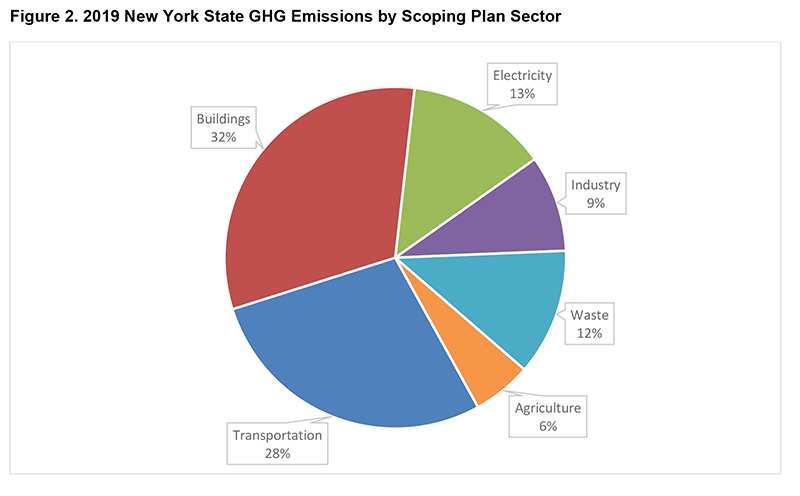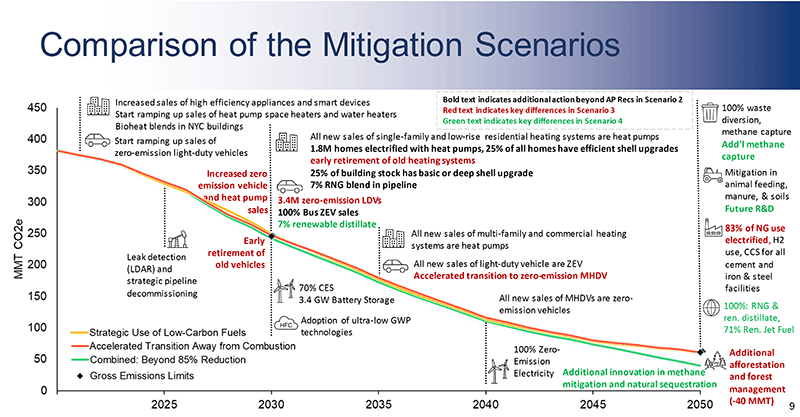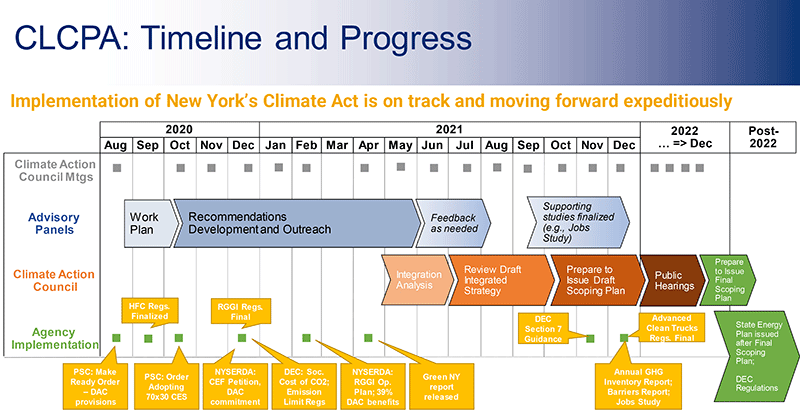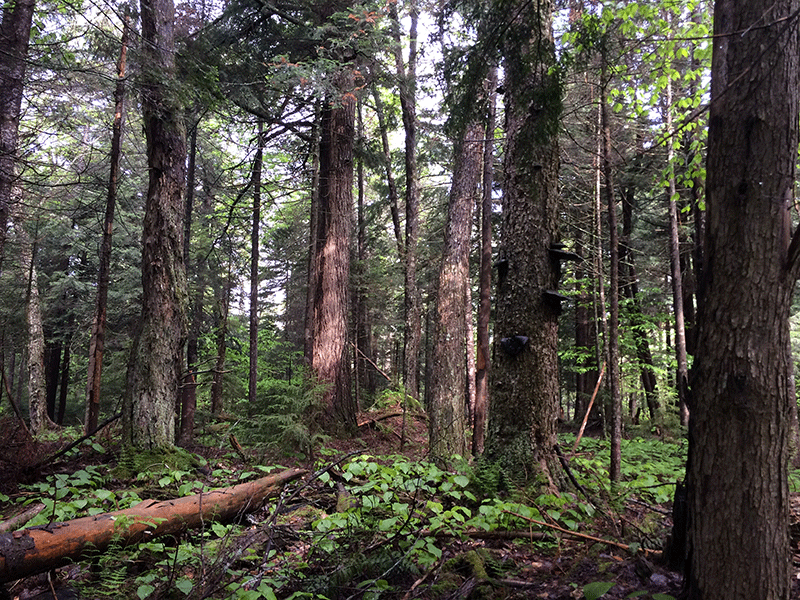Protect the Adirondacks has reviewed the 861-page Draft Scoping Plan (“Plan”) of the NYS Climate Action Council (NYSCAC), released in December 2021. The Draft Scoping Plan is a “framework for how the State will reduce greenhouse gas emissions and achieve net-zero emissions, increase renewable energy usage, and ensure climate justice.” The Draft Scoping Plan is being used as a strategy document to gather input and ideas from New Yorkers to help the NYSCAC organize and put together a formal draft climate change plan for New York by the end of 2022. While Protect the Adirondacks broadly supports much of the Draft Scoping Plan, there are a number of ways that New York’s climate change program can be improved in a formal draft plan. Our comments that follow attempt to highlight the major areas where we support the ideas and recommendations in the Draft Scoping Plan and enumerate areas where a formal Draft climate change plan should be much stronger.
The NYSCAC is taking public comments until June 10th (see letter writing, emailing, and automatic email information below). The NYSCAC is also holding public hearings, both in-person and virtual, across the state; see dates and locations below.
We encourage people to read the whole plan, even though it is massive. There’s a summary here. This plan contains a broad strategy where there is much to support, though meeting goals of removing all fossil fuel use from New York’s power generation will be very difficult. Removing our dependence on fossil fuels for our homes, businesses, and for our food and travel will be even harder. The reality is though, that we have no choice. We must make these vital transitions in order to preserve the current environmental health of the planet and our way of life. Now is the time for bold, brave, and smart actions and public policy by New York State.
The chart below is from the Climate Action Council and shows the sources of greenhouse gas emissions in New York. Buildings and transportation are the two biggest sources of pollution. Basically, how we live, many of us in single family homes, and how we move around our communities and the state, many of us in automobiles, are the chief sources of carbon pollution in New York. The same is largely true across the U.S. Buildings in New York produce 32% of greenhouse gas emissions and transportation produces 28%. The other chief sources are electricity generation in power plants, which produces 13% of greenhouse gas emissions. Then comes “waste” at 12%, which is how we deal with our garbage or solid waste, followed by industry at 9% and agriculture at 6%.
Reforms are needed across New York to change the way we all live in the modern world. The most effective remedies, and most difficult challenges, in front of us are transitioning off of fossil fuels for how we power and heat our homes and in our transportation. At the same time we need to do these things for how and where we work all across the U.S. economy. No small feats. This isn’t the 100 easy things that one can do to save the environment, these are the five really hard things we need to do to save the planet. The chart below spells out some ideas for the magnitude of change by 2050.
The Climate Action Council has an ambitious timeline (see below) that aims for a formal draft report by the end of 2022. The release of the formal draft report will be followed by a new round of public hearings, likely at some point in the first half of 2023, and then a final report will be issued at some point after that. They NYSCAC has an enormous task in front of them, that effects all New Yorkers, so New Yorkers should be involved in this process from beginning to end.
While Protect the Adirondacks broadly supports much of the draft scoping plan, there are a number of ways that New York’s climate change strategy can be improved in a final draft plan at then end of 2022. The Draft Scoping Plan makes recommendations for greenhouse gas emission reductions in two major sections. The first major section “Sector Strategies” set out strategies by industry sector, which include transportation, buildings, electricity, industry, agriculture and forestry, and waste. The next major section “Statewide and Cross- Sector Polices” sets out policies for a transition away from natural gas, land use, local government, and adaptation and resilience.
Here’s a summary of the major parts of the Draft Scoping Plan, but please note that this plan includes hundreds of policy recommendations and ideas. We encourage people to read the whole report.
Transportation: The NYSCAC states that “transportation” was responsible for 28% of the New York’s greenhouse gas emissions in 2019. The Draft Scoping Plan calls for transition to three million zero emission vehicles (ZEVs) in the fleet of automobiles in New York by 2030 and 100% by 2050. The Draft Scoping Plan sets out a number of ways that these goals will be attained. In addition to the transition to ZEVs, the Draft Scoping Plan also enumerates possible new state investments in public transit and enumerates a variety of ways to reduce the total “vehicle miles traveled” (VMT) by making communities in New York more hospitable for walking and biking.
Protect the Adirondacks supports a number of the policy recommendations in this section, including adoption of California’s “Advanced Clean Cars 2 Regulations;” Converting New York’s trucks, buses, and non-road equipment (including construction and farm equipment) to zero-emissions technologies; Prioritizing medium and heavy-duty vehicles that impact disadvantaged communities; Expanding options, access, improving reliability, making public transportation more affordable, and focusing on the needs of unserved and underserved communities outside of current public transportation systems; and, Changing New York’s Smart Growth Public Infrastructure Policy Act (ECL, Article 6) to prevent sprawl and build communities focused around climate change mitigation.
Protect the Adirondacks also supports programs highlighted in the Draft Scoping Plan for “variable pricing and parking policies,” and “higher registration fees” for carbon intensive vehicles, mileage-based user fees, and other special assessments to finance transportation sector improvements. We agree that there clearly needs to be disincentives for low mileage vehicles as part of New York’s climate change program.
While, Protect the Adirondacks supports incentives to increase the number ZEVs purchased in New York, these incentives should be higher. Beyond a higher direct rebate, we suggest that there be a sales tax waiver for all ZEVs purchased by New York State residents. New York State will not meet it climate change goals unless we can make ZEVs affordable for working families across the state. Right now, most ZEVs are not affordable for working families in New York.
Buildings: The Draft Scoping Plan states that buildings in New York State, both residential and commercial, produce 32% of greenhouse gas emissions. Buildings, which basically means the way that New Yorkers live and work, are the biggest source of greenhouse gas emissions in the state. To meet this challenge, the Draft Scoping Plan provides an ambitious goal to electrify 85% of homes and commercial building space in New York State by 2050. While Protect the Adirondacks supports that overall goal, we do not believe that the Draft Scoping Plan goes far enough and we urge that the NYSCAC look at other policy options that will help to meet this goal.
As a general approach, Protect the Adirondacks supports a variety of programs and incentives to help “electrify” and make more energy efficient primary residences and long-term rental units. We support ideas highlighted in the Draft Scoping Plan for adopting regulations that prohibit the replacement of fossil fuel equipment at the end of its useful life; Adopting new and stronger local and state-wide codes that require highly efficient, zero-emission standards for new residential and commercial buildings; Requiring energy benchmarking and disclosure for multifamily and commercial buildings; Providing financial incentives and expanding access to public and private low-cost financing for building decarbonization; and, Expanding the use of high-efficiency heat pumps to retrofit, electrify, and decarbonize existing commercial and residential buildings.
Protect the Adirondacks supports an expansion of tax credits or rebates that incentivize New Yorkers to invest in energy efficiency for their primary residences. Many New Yorkers would rather put money into their homes than send it to the state. The Draft Scoping Plan needs stronger incentives for insulation, window replacement, energy efficient appliances, electrification of heating systems, among other household upgrades. Working families in New York State will only be able to undertake these activities if there is a meaningful immediate, short-term economic benefit. A formal draft plan needs to programs and policies that provide a short 5- to 10-year return on investment for New Yorkers to electrify and decarbonize their homes and businesses. The state should get into the loan business. Currently, the loans available are high interest (or low interest require a number of points) and burdensome to working families.
Protect the Adirondacks believes that there should be a series of disincentives for second homes (and third homes, and fourth homes, etc.) due to their wasteful energy use and land use. The report does not address the major issue that Upstate New York, and many parts of New York City, the lower Hudson Valley, and Long Island as well, are heavily populated with buildings and apartments that are not occupied on a year-round basis, and many are owned by non-resident landowners from out of state. The Draft Scoping Plan failed to address this issue either in “Building” section or the “Land Use” sections and this is a major weakness in the report. This issue must be tackled in the formal draft plan.
Electricity Generation: The Draft Scoping Plan states that electricity generation in New York State, both residential and commercial, is responsible for 13% of greenhouse gas emissions. According to the Draft Scoping Plan, fossil fuel generation, including natural gas, oil, and dual-fuel generation, produces more than 43% of statewide electricity. Wind produces just 3%, solar produces less than 1%, hydro-power produces around 20%, and nuclear around 33% (but nuclear will see reductions as Draft Scoping Plants are closed). In order to achieve electricity system decarbonization by 2040, the state proposes to continue expansion of land-based and offshore wind and solar.
Protect the Adirondacks supports recommended strategies to accelerate growth of large-scale renewable energy generation by facilitating transmission and distribution upgrades and the Draft Scoping Plan’s support for the expansion of clean distributed energy generation and distributed energy resources. We also “Community Choice Aggregation” programs such as community solar projects.
Protect the Adirondacks calls on the NSYCAC to adopt a formal goal of putting solar units on two million rooftops across the state. The formal draft plan needs to detail how an average household across New York can afford to install rooftop solar at an affordable rate for working families. Right now, rooftop solar is a financial burden. The formal plan must include detailed planning for how to make rooftop solar for residences and businesses affordable for working families.
Protect the Adirondacks is at a loss as to why the role of the New York Power Authority is minimized for the development of either onshore or offshore wind farms or solar farms. It seems that a strategy for the NYSCAC to endorse is for New York State to make new investments to expand the capacity of the New York Power Authority to undertake these kinds of projects. The investments that New York State made decades ago to build a series of public hydro-power facilities should be replicated with public wind and solar power projects today. In the long run public ownership of these facilities will make these projects more affordable and profitable for the state.
Industry: The Plan states that industry in New York State is responsible for 9% of greenhouse gas emissions. The Plan addresses concerns that changes in New York public policy to combat climate change may alienate businesses and industry and push them to leave to state for states that are less restrictive. The Plan lays out a series of incentive-based strategies based on “four pillars” of energy efficiency, switching to low-carbon fuels (including renewable electricity), decarbonizing the electricity supply, and negative emissions.
Agriculture and Forestry: The Plan states that agriculture and forestry in New York State is responsible for 6% of greenhouse gas emissions. The Plan lays out strategies for reducing emissions in agriculture and forestry, focusing heavily on methane and nitrous oxide. The Plan it also discusses how the agricultural and forestry can produce more goods for local use, thus reducing demand for imported goods. The Plan also provides strategies for increasing carbon sequestration.
On agriculture and forestry, the Plan focuses on sustainable forest management; livestock management; soil, health, nutrient management and agroforestry; and climate-focused bioeconomy.
This Plan’s statements on forestry and carbon sequestration, and its recommendations around forest management, are inadequate and represent some big weaknesses. For some background information click here to read “Forests and Carbon.” In New York State we need programs aimed at maximizing long-term carbon storage in our forests.
Increasing carbon sequestration in New York’s 18.6 million acres of forests will help to meet climate change goals, but it is not as important as ending use of fossil fuels and conservation and energy efficiency in buildings and transportation. While playing a secondary role, a new comprehensive forest protection program for New York will be less expensive to design and implement than these other incredibly difficult and challenging goals. In reality, we just want to let the trees we have in New York right now to keep growing and to find places where new trees can be planted and grow. The Plan states that New York has lost 10% of its forests in the last decade. That means we’re going the wrong way. We need to set a short-term goal of no net loss of existing forests and for significant expansion of forests in New York by 2050.
The Plan looks at a 30-year time frame, from now until 2050. Any tree planted today is not going to help us much in total carbon storage in the next 30 years. That tree will grow in 30 years to 8, 10 or 12 inches in diameter if we’re lucky. This plan needs to prioritize new investments to preserve intact forests in public ownership and to incentivize forever wild privately owned forests throughout New York through new state programs and easements that will keep these established forests intact and growing.
The Plan fails to state that the science is clear that mature forests, those 50 to 125 years old, which is much of the Forest Preserve, and many of the private forests in the state, are the forests that will sequester and store the most carbon in the future. A 20” diameter tree stores 4 times the carbon as a 10” diameter tree. Half of a tree’s dry biomass is carbon. Tree size matters.
On the state’s 5.8 million acres of public lands, we should set goals for long-term carbon storage over the next 100 years as many of these forests are now around 75 to 100 years old and in their peaks for carbon storage.
On the state’s 13.7 million acres of existing privately owned forests, we need to change the state’s focus from sustainable timber management to long-term carbon storage. We need to set a goal for a significant acreage of the state’s private forests to be managed as forever wild forests for long-term carbon storage. We need a new program that allows for no timber harvesting to maximize carbon storage with a minimum of five acres. We need to enroll millions of acres of private forest lands into such a new program. If one does not want to cut their trees, that’s great, we just want them to let their forest grow. The NYSCAC needs to think big. Think 5 million acres in forever wild easements for long-term carbon storage in the state’s private forests.
The Plan relies heavily on the same set of public policies that have been in place for 50 years. Long-term carbon storage in New York’s forests is a very different objective than a constant timber products supply or sustainable forestry. So we need new programs and new objectives for a new purpose.
On lands where timber harvesting is active we need to incentive forest products that lock up carbon in wood products like tables, chairs, desks, buildings, and anything else. We need to disincentivize wood products that simply re-emit carbon to atmosphere quickly like burning wood chips for power.
Protect the Adirondacks supports a much bolder program for maximizing long-term carbon storage in New York’s forests.
Waste: The Draft Scoping Plan states that waste in New York State is responsible for 12% of greenhouse gas emissions. In the emissions from waste across the state 78% are methane gas, emitted from landfills as garbage decomposes. Long-term strategies to reduce packaging need to be redoubled in New York’s climate change Draft Scoping Planning. The tried and true solid waste management strategies of “reduction, reuse, and recycling” need a fundamental reboot.
Across New York, 18% of the waste stream is food scraps. The Draft Scoping Plan needs stronger programs that emphasize the distribution and consumption of extra food as well as widescale composting. In essence, we need to generate far less trash and compost much more.
Protect the Adirondacks supports packaging legislation reforms, stronger reduction, reuse, and recycling programs, and stronger food use and composting programs.
Greenhouse Gas Pricing: The Draft Scoping Plan states calls for a new program for pricing greenhouse gas emissions that is “designed to bring about change in the market and promote equity.” These are the three main ideas the Draft Scoping Plan puts forward for greenhouse gas pricing that are designed to reduce emissions.
- A tax or fee establishing a carbon price referred to as a carbon pricing.
- A program that caps emissions across the economy or within particular sectors and allocates emissions primarily through an auction mechanism that provide revenues for investment, known as cap-and-invest.
- A clean energy supply standard, which would require providers of liquid and gaseous fuels across the economy to reduce the carbon intensity of fuels they introduce into commerce.
Protect the Adirondack supports these concepts.
Managed Transition from Fossil Fuels: The Draft Scoping Plan is centered around decarbonizing the way New York State generates electricity and decarbonizing New York’s economy. The Draft Scoping Plan’s focus is on electrifying 85% of New York’s residential households and moving them off of fossil fuels. The Draft Scoping Plan states that this huge task will not be easy and calls for a “managed transition,” though its states it will seek “the most equitable and effective strategy for transitioning from fossil gas while maintaining affordable, safe, and reliable service.”
The Draft Scoping Plan lists some rather monumental challenges. Here are some of its major aims: 1) Utilities need to transform their business models away from fossil fuels; 2) Local governments need to consider a broad range of building code upgrades and changes; 3) Commercial and industrial gas customers need to electrify their business establishments and operations; 4) Residential and commercial gas and oil utility customers need to retrofit heating, hot water, and cooking appliances in homes and businesses; 5) State regulators will need to somehow “equitably and legally” balance shareholder and customer interests in this massive transition.
Protect the Adirondacks agrees that New York’s transition away from fossil fuels will be a massive undertaking, which we support, though we recognize how difficult it will be. We support a variety of programs and policies to try and facilitate this fundamental reforms.
Land Use: The patterns of land use and development across New York directly impact carbon emissions. Across New York, we need to revitalize communities, large and small, around climate change mitigation strategies and Draft Scoping Planning. The Draft Scoping Plan includes a standard list of buzz words and programs that need to be utilized and strengthened, including the “Protection, Restoration, and Monitoring of Natural and Working Lands, new efforts around “Forests and Farmland in Municipal Land Use Policies” and, of course, “Smart Growth.”
Under the 2019 Climate Leadership and Community Protection Act (CLCPA), state agencies are mandated to weigh the impact of climate change in their decisions. Section 7(2) of CLCPA requires all State agencies to determine whether their administrative approvals are consistent with the attainment of, or will interfere with the attainment of, the statewide greenhouse gas emission limits in ECL Article 75. If inconsistent, they are required to explain why, and to identify alternatives or mitigation measures.
Protect the Adirondacks is concerned about compliance with the Climate Leadership and Community Protection Act by the Department of Environmental Conservation and Adirondack Park Agency. We strongly recommend that the Draft Scoping Plan enumerate how these agencies, and all other state agencies, will include the impact of climate change in their statutory and regulatory responsibilities and decisions. Section 7(2) of CLCPA requires all State agencies to determine whether their administrative approvals are consistent with the attainment of, or will interfere with the attainment of, the statewide greenhouse gas emission limits in ECL Article 75.
To date, both the DEC and APA have failed to do this work, and are violating ECL Article 75. To date, the DEC and APA have failed to take into consideration long-term carbon pollution in its review of major projects. Land clearing for roads, buildings for vacation homes, or industrial facilities are not addressed by these agencies during regulatory reviews for their long-term carbon pollution impacts.
30 by 30 legislation is at play in Albany that set goals for the protection of 30% of New York State as intact protected forestland. This goal (though it should be 50%) should be part the regulatory framework of state agencies. A formal draft plan needs to include a requirement, and draft language, that the Legislature amend all laws of state agencies to require all state agencies to include climate change impacts and mitigation in their regulatory and statutory responsibilities. Currently, at least in the Adirondack Park, the DEC and APA are blowing off the Climate Leadership and Community Protection Act.
Local Government: The Draft Scoping Plan emphasizes the critical role of local government in the state’s planning for climate change mitigation. The Draft Scoping Plan details five strategies to encourage and support “local climate action” by the state’s local governments: 1) A statewide “dashboard” of greenhouse gas emission data community by community; 2) Draft Scoping Planning where local governments take the lead on conservation and energy efficiency efforts in their local building codes; 3) Model laws for siting clean energy facilities; 4) Assistance, support, and guidance, for incentives, technical assistance, and centralized procurement services, and more; and 5) State support for local community green power clean energy initiatives. These are all programs and policies that Protect the Adirondacks supports.
Protect the Adirondacks sees these strategies as reasonable.
Adaptation and Resilience: The Draft Scoping Plan is realistic about the ecological and public health damage that New York is likely to experience in the decades ahead between now and 2050. The Draft Scoping Plan includes strategies for adaptation and resilience in three areas — building capacity, communities and Infrastructure, and living systems. This is a complete list and this type of planning will be necessary in the future.
Make a Comment at Statewide Public Hearings (In-Person and Virtual)
The Climate Action Council will hold public hearings across the State to receive public input on the Draft Scoping Plan. These will be a mixture of in-person and virtual.
Click here for specific information regarding public hearing locations, capacity, parking, public transit options, health and safety protocols. Pre-registration is encouraged but not required for the in-person hearings. Priority seating and speaking will be given to those who pre-register. Here are the dates and locations:
Tuesday, April 12, 2022, 4 PM, Binghamton, SUNY Binghamton
Thursday, April 14, 2022, 4 PM, Albany, Empire State Plaza
Tuesday, April 26, 2022, 4 PM, Syracuse, SUNY-ESF
Wednesday, April 27, 2022, 3:30 PM, Buffalo, Buffalo and Erie County Public Library
Tuesday, May 3, 2022, 4 PM, Brooklyn, NYC College of Technology
Saturday, May 7, 2022, 10 AM, Virtual
Tuesday, May 10, 2022, 4 PM, Tupper Lake, The Wild Center
Wednesday, May 11, 2022, 4 PM, Virtual
If you plan to attend one of these sessions and make a statement please let us know. Good luck and thank you.
Here’s Where to Submit a Public Comment
Please send in your public comment on the draft scoping plan of the NYS Climate Action Council by June 10, 2022. Thank you very much.
Comments can be mailed to this address:
NYSERDA
17 Columbia Circle
Albany, NY 12203
Public comments can also be emailed to: scopingplan@nyserda.ny.gov










